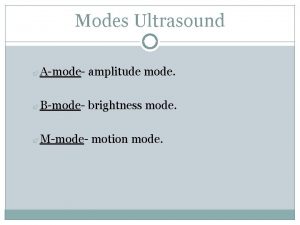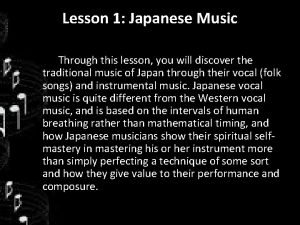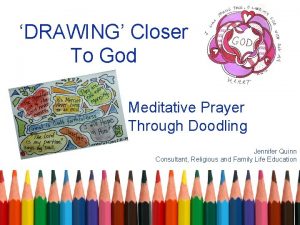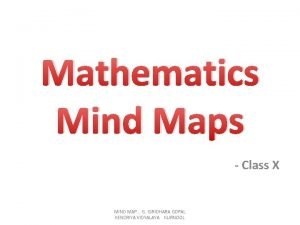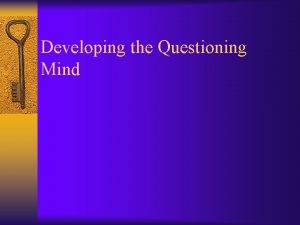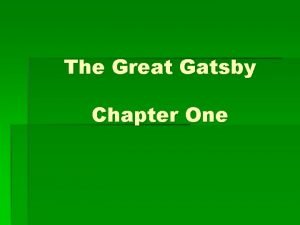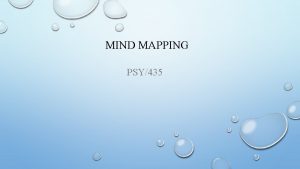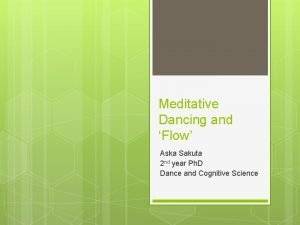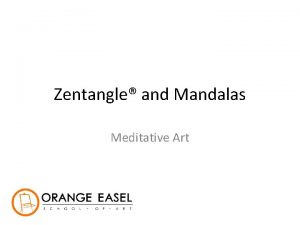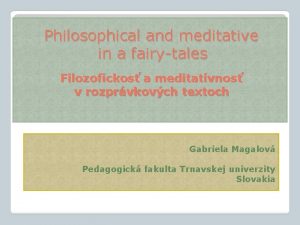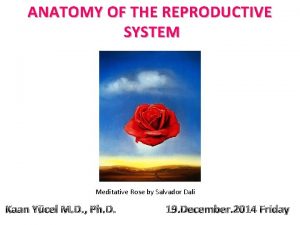The Meditative Mode The Mind in the State














- Slides: 14

The Meditative Mode The Mind in the State of Thinking

Combines the religious practice of meditation with verse (yet the primary focus isn’t worship, but to explore an object or event through thought and language) Defining Meditative Poetry An ancient practice, especially in Asian poetry (Ex. haiku and Chinese Buddhist poetry) Though the meditative tradition is influenced by various Asian traditions, it became much more expansive in the west (Ex. Wordsworth’s “Tintern Abbey, Stevens’ “Sunday Morning” and Elliot’s “Waste Land” are technically meditative poems)

Two strains of mediation are important to understanding the tradition of meditative poetry in America: • Ignatius of Loyola (formalized the process of meditation, as a channeling of memory, understanding and will). Two Strains of Meditation • This method of meditation fell into three main parts: A) prayer and composition of place; B) the examination of points (analysis); the colloquies (the dialogue with God as a climax) (Martz 1962, 27 -32); • Puritan: emphasized self-examination, applying Bible verses to contemporary, everyday life; Ralph Waldo Emerson: freed the meditation from its theological underpinnings and its reliance on the Bible. He encouraged poets to view nature as a storehouse of symbols that they could use simply by relying on their imagination. Walt Whitman and Emily Dickinson took meditation into this direction and paved the way for Modernist and Postmodernist practices in poetry (Lawson 1994).

American Poetry Built on a Meditative Tradition The meditative mode is long lived in American verse due to the Puritan strain in the culture (first two major American poets were meditative poets, Emily Dickinson and Walt Whitman) Originally, meditative poetry in America had the goal of achieving unity with God (Anne Bradstreet) In Dickinson, mediation became about questioning thought and reality in a way that belied epiphany (this doesn’t mean Dickinson questions God’s existence; on the contrary, the God of a Dickinson poem becomes a lover and friend who guides the speaker through suffering) In Whitman, meditative practice combines mind and body, and this mind/body unity becomes soul.

• English Romanticism obviously greatly influenced American poetry in the 19 th century • Romanticism also relied a great deal on the meditative mode since it focused on the poet’s personal and imaginative experiences in nature Influence of English Romanticism • The process of thought in Romanticism is meant to evoke deep feeling in the poet and reader, resulting in an epiphany about the individual’s relationship with the natural world (In a sense, the Romantics replace “God” with nature) • The major philosophical movement of the U. S. in the 19 th Century was Transcendentalism (an offshoot of European Romanticism, it also focused on the individual in deep thought and feeling about nature) • The primary goal of Transcendentalists like Emerson, was to achieve unity with nature, which will then get the soul closest to the divine (in this tradition, the mind is, in effect, soul, because it’s what carries and communicates the essence of the individual)

The method of the three main steps (composition of place, examination of points, colloquies) had survived into the twentieth century in many poems, as had the devotional practice of verse meditation The Meditative Mode in Modernism and Contemporary Poetics Leading modernist poets like T. S. Eliot and Wallace Stevens began to fragmentize the process, blending thoughts and sense perceptions in a sort of spiritual diary (Parini 1993, 12) This practice, along with the influence of South American poetry, combines to add a strain of surrealism in American poetics, exemplified by poets like James Tate and Charles Simic It’s important to note that the meditative mode in modern and contemporary poetry is mainly interested in the poet’s mind in action, which is achieved, usually, by lyrical language and fragmented form (story, accessibility, and realism are either secondary or completely discounted)

Examples of Meditative Poetry

Emily Dickinson

“I felt a Funeral, in my Brain, And Mourners to and fro Kept treading - till it seemed That Sense was breaking through And when they all were seated, A Service, like a Drum Kept beating - till I thought My mind was going numb -

Wallace Stevens

One must have a mind of winter To regard the frost and the boughs Of the pine-trees crusted with snow; And have been cold a long time To behold the junipers shagged with ice, The spruces rough in the distant glitter “The Snowman” Of the January sun; and not to think Of any misery in the sound of the wind, In the sound of a few leaves, Which is the sound of the land Full of the same wind That is blowing in the same bare place For the listener, who listens in the snow, And, nothing himself, beholds Nothing that is not there and the nothing that is.

Audre Lorde

“Coal” Is the total black, being spoken From the earth's inside. There are many kinds of open. How a diamond comes into a knot of flame How a sound comes into a word, coloured By who pays what for speaking.

Exercise Go outside and walk for a bit, look around for something in nature that interests you. Once you find something, sit and watch it for a bit then begin to free-write about it. Try not to edit. Simply allow your thoughts to flow. Let associations outside the immediate object or event to come, and don’t worry if they don’t immediately seem to tie in. The trick here is to write thought into action. A good way to do this exercise is to let strange images and wording happen so that your unconscious mind naturally takes charge of the language.
 What is a mode ultrasound
What is a mode ultrasound What music is basically meditative in character
What music is basically meditative in character Pray drawing
Pray drawing Focus mode and diffuse mode
Focus mode and diffuse mode Mode địa chỉ tức thì là mode
Mode địa chỉ tức thì là mode Difference between real mode and virtual mode of 80386
Difference between real mode and virtual mode of 80386 Timer in 8051
Timer in 8051 Gartner mode 1 mode 2
Gartner mode 1 mode 2 Perbedaan (planning mode) dan (evolutionary mode)
Perbedaan (planning mode) dan (evolutionary mode) 8086 vs 8088
8086 vs 8088 Polynomial class 10 mind map
Polynomial class 10 mind map Master mind map
Master mind map A wandering mind is an unhappy mind
A wandering mind is an unhappy mind The critical mind is a questioning mind
The critical mind is a questioning mind Describe the ambiguity in nick's descriptions of gatsby
Describe the ambiguity in nick's descriptions of gatsby
